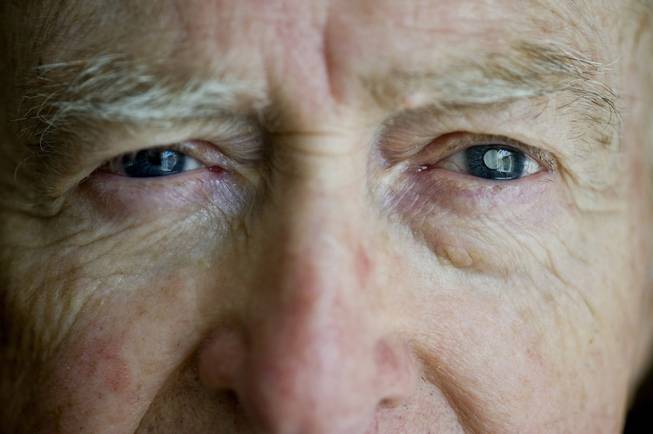
Anna Reed / Orange County Register/MCT
Dan Dunbar, 82, poses for a portrait at his home in Costa Mesa, Calif., on Wednesday, March 12, 2014. Dunbar has age-related macular degeneration. In November 2011, he had a telescope implanted in his left eye to improve his vision.
Sunday, May 11, 2014 | 2 a.m.
SANTA ANA, Calif. — Dan Dunbar lets you look closely at his left eye. And then deeply into it.
It's impolite to stare, of course, but it has a hypnotic effect: It resembles a cat's eye with its silky glow. Gen Xers will immediately recall their Steve Austin "Six Million Dollar Man" doll with the bionic left eye.
However, what's inside Dunbar isn't theoretical 1970s NASA gadgetry, but 21st-century practical technology: a tiny telescope, with a lens that's 3.2 millimeters in diameter, surgically implanted into his eyeball. He had the procedure done in 2011 to improve his vision, which had been failing for years because of age-related macular degeneration, or AMD, a condition characterized by a blurry gray or dark spot in the central vision.
The telescope, called CentraSight and made by VisionCare Ophthalmic Technologies Inc., is one of several implantable devices to be developed in recent years to treat a variety of vision problems, from the mild to the devastating: There have been advances in removing cataracts, as well as sophisticated hardware to reduce the impact of glaucoma and even certain kinds of blindness that had few treatments before.
The effect on Dunbar, 82, has been profound. For years he relied on his peripheral vision, peering around the fuzzy center. With the telescope magnifying his field of vision, he can see details that had eluded him for so long: walk/don't walk signals at intersections near his home in Costa Mesa, Calif.; the contours of the face of his wife, Jean. After much practice, he can use the telescope to read, something he'd largely given up; he's resumed his passionate hobbies, model trains and woodworking.
And when he goes skiing, an avocation he picked up only after he retired, he can actually see where he's going now.
"I don't run into closed fences like I used to," he says, recalling his latest outing to Mammoth Lakes, just two weeks ago. "I can see my kids on the ski slopes.
"I want people to know it's not utopia, but it sure is a big boost over what you normally have" with AMD. "It certainly has improved my life."
The vast majority of Americans has some kind of vision problem, but most are "refractive errors" in which the eye doesn't bend, or "refract," properly when light comes in. Disorders such as myopia (nearsightedness) and hyperopia (farsightedness) are easily correctable with eyeglasses.
About two-thirds of U.S. adults wear some type of corrective lenses, either eyeglasses, contacts or reading glasses, according to the National Eye Institute.
Other problems are more serious, however, and can lead to severe vision loss, or partial or total blindness.
Glaucoma, caused by steadily increasing pressure inside the eye, affects more than 2 million Americans age 40 and older, and 3 million older people have age-related macular degeneration, a condition in which the macula, a spot on the retina behind the eye, deteriorates. More than half of people who live to 80 get cataracts, when the lens becomes cloudy and limits vision.
The new generation of tiny, sophisticated optical hardware is being developed just in time: In 1980, there were 26 million people age 65 and older in the United States; by 2020 that number will be 55 million. In California, men who make it to age 65 have a life expectancy of 83.9 years; for women, it's 86.5.
"There are a lot of patients entering those elderly years, where these conditions do become an issue, and wouldn't be an issue if we didn't live so long," said Dr. Roger F. Steinert, an ophthalmologist who's director of the University of California-Irvine's Gavin Herbert Eye Institute. "And we're not only living longer, we're living longer, healthier."
Dunbar sat in his bright, cozy living room discussing when his vision first began to slip. It was around 2000, he said. The "dead spots" developed so slowly in both eyes that he trained himself to view the world without looking at it head-on.
"It's gray, there's just no sight at all in there, it's just like you kind of erase out all the vision. ... I learned not to look at things," he said.
The mind plays tricks on you to compensate. For Dunbar, he literally hallucinated a few times, seeing objects that weren't there. At a play, he watched seven cast members onstage when he knew there were only four — not double vision; they all did their own thing, independently of one another.
Another time, when he was driving with Jean on the northbound Interstate 5, he thought he saw another car start to levitate — "float up, go along with us, go through a bridge. Didn't hurt anybody, didn't do anything. Come out the other side, then disappear. You begin to think, 'Hey, I'm losing it.'"

Join the Discussion:
Check this out for a full explanation of our conversion to the LiveFyre commenting system and instructions on how to sign up for an account.
Full comments policy